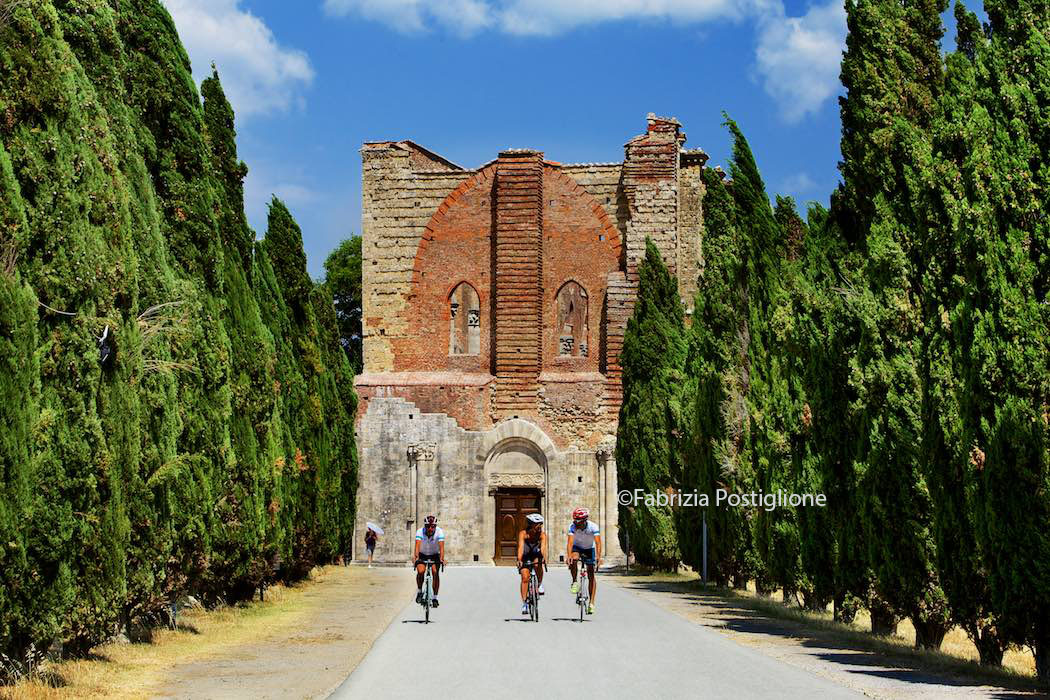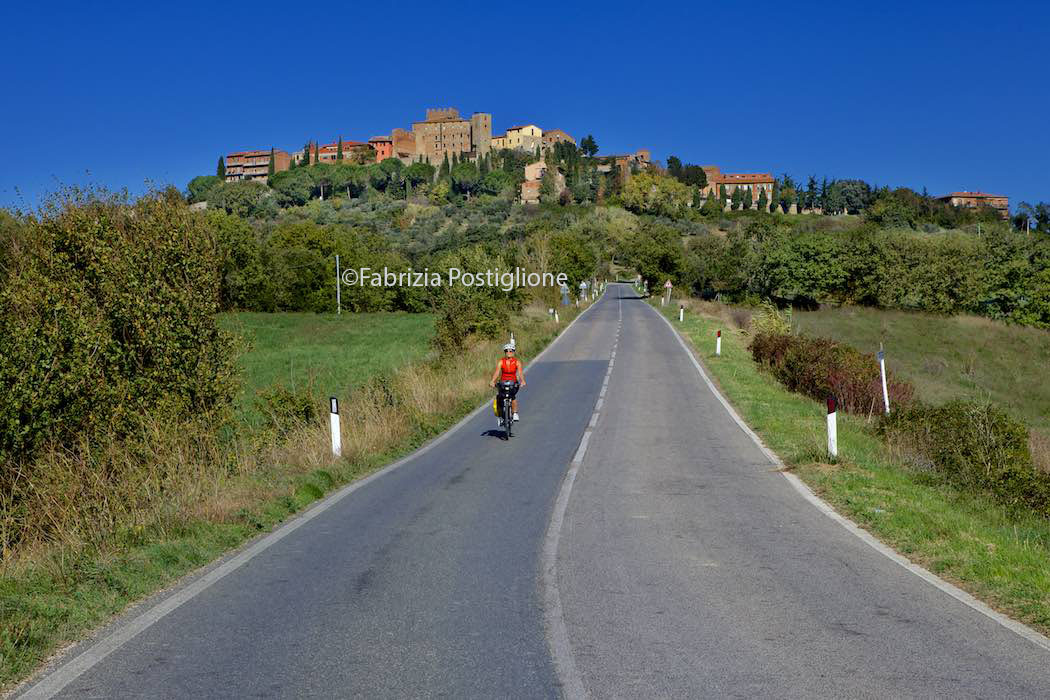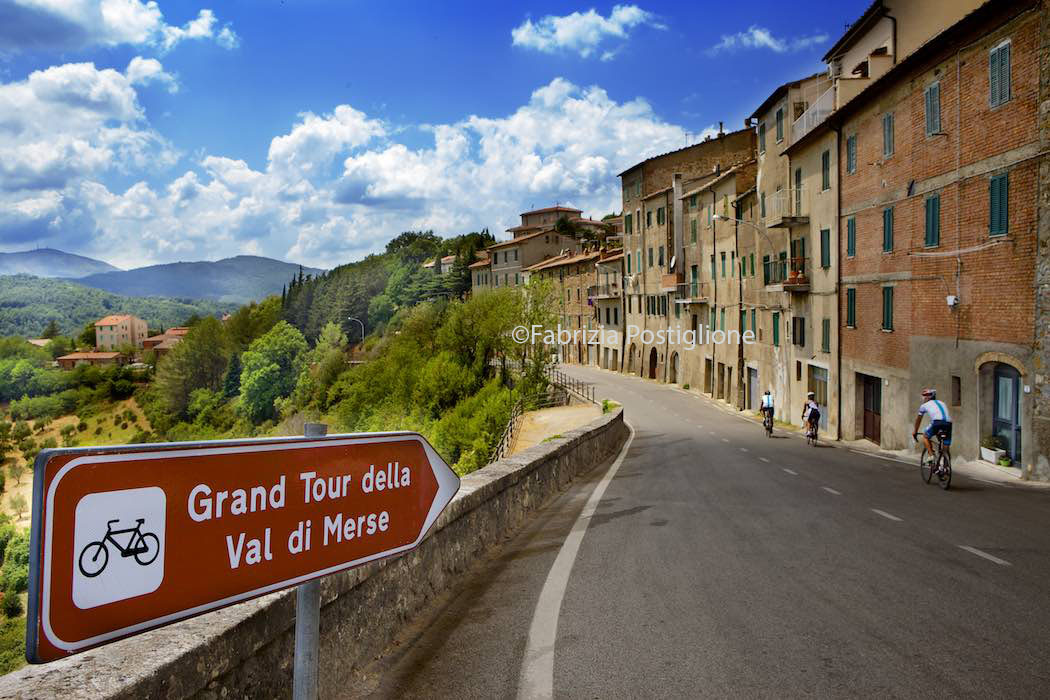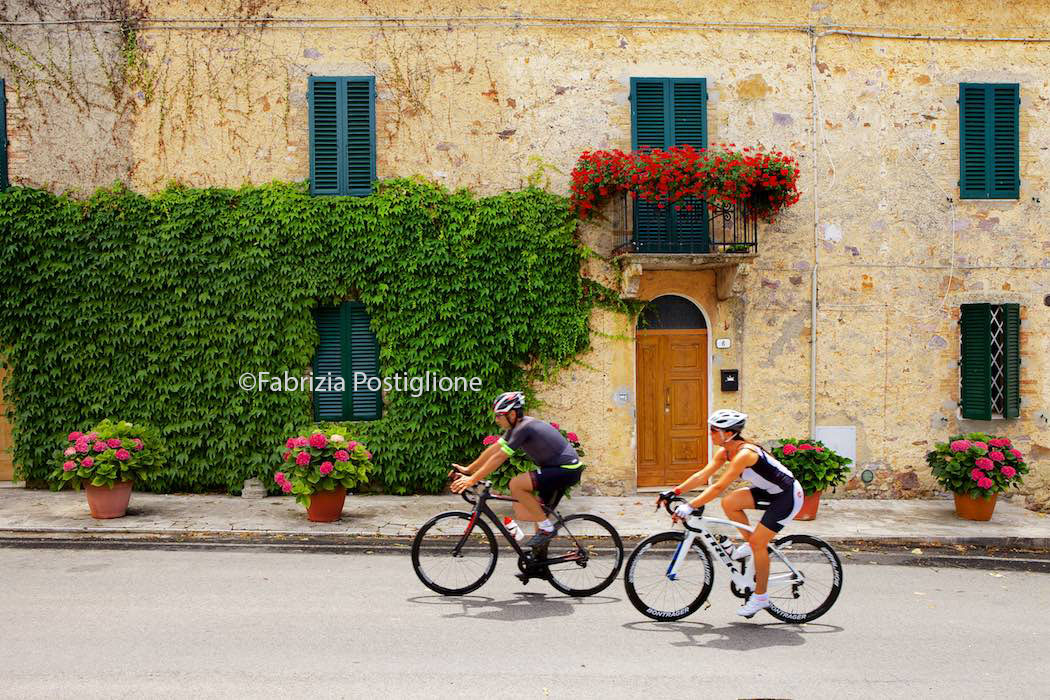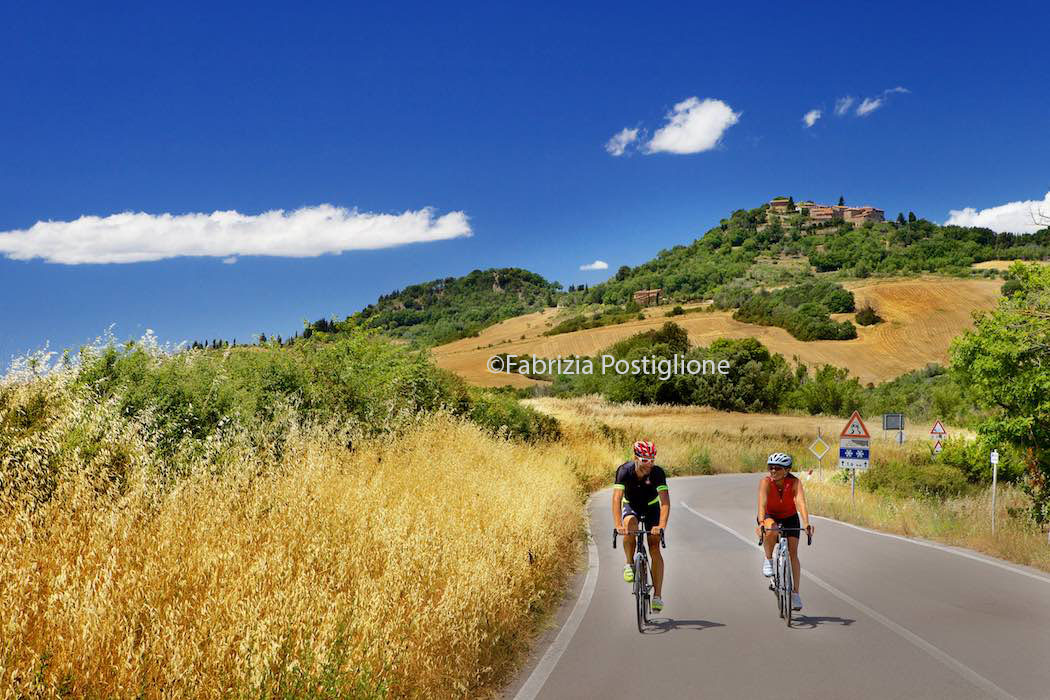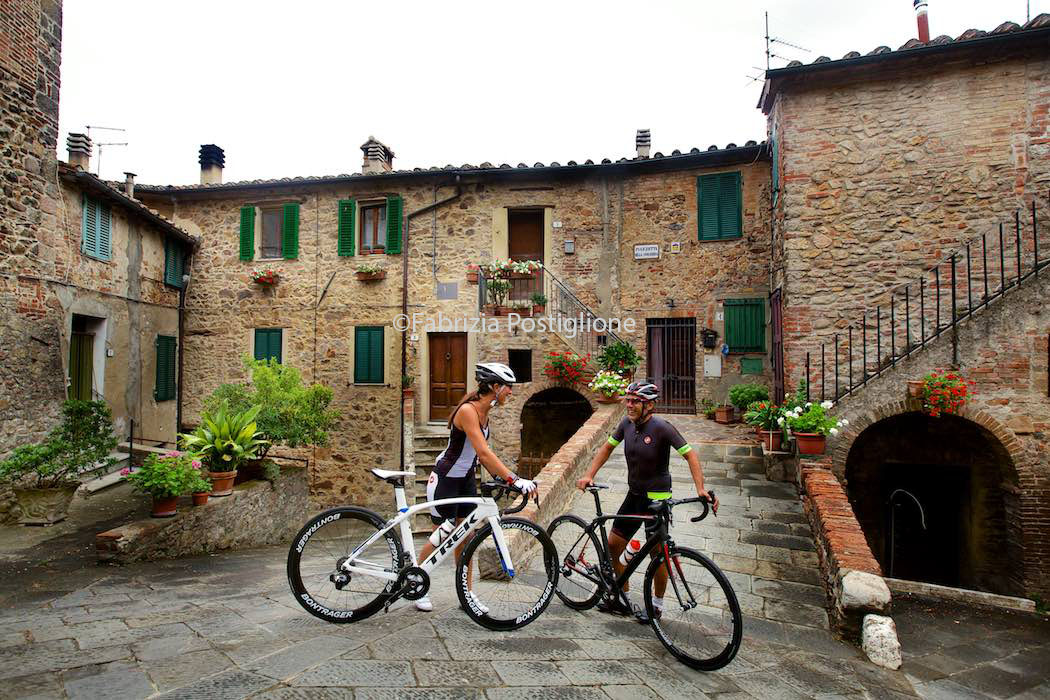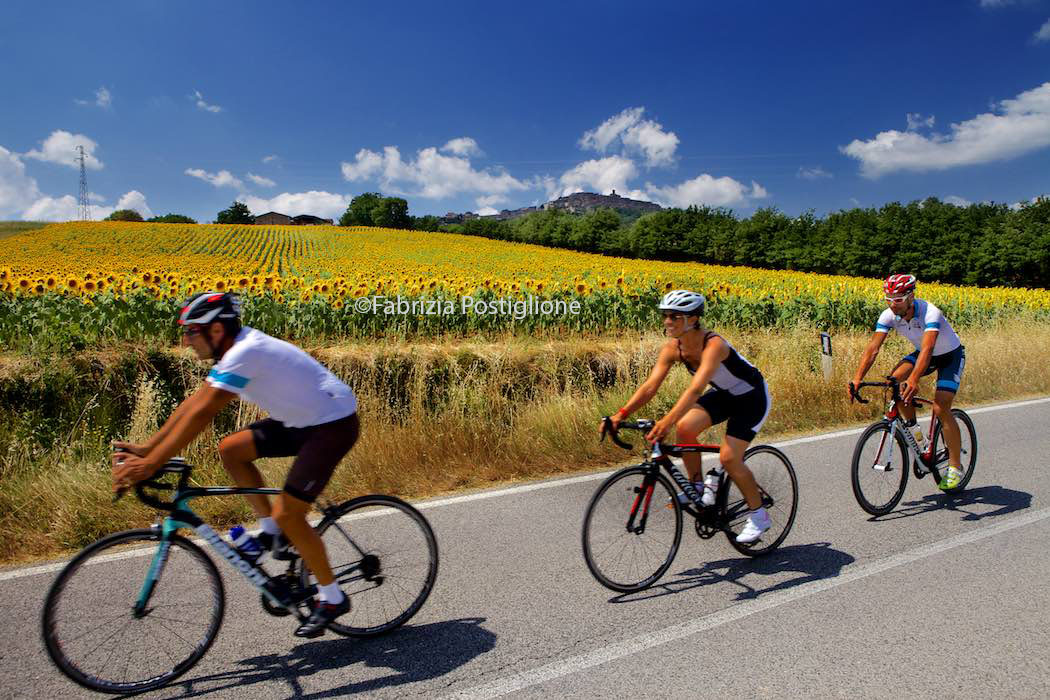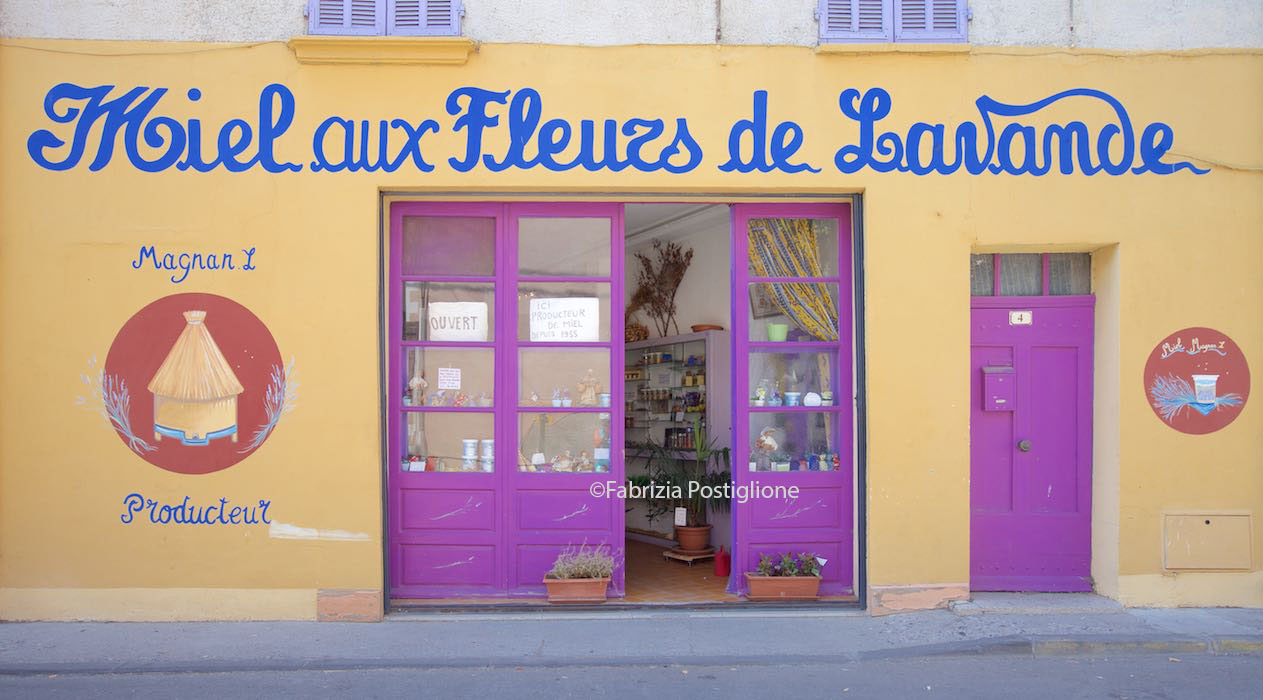We will leave for a two-wheeled journey through nature, art and culture in the wooded heart of the most intimate and secluded Tuscany, between the Merse and Elsa river basins. We will cross the most secret areas of the Terre di Siena, dotted with medieval villages (never crowded with tourists) and ancient parish churches. We will glide happily into the sunny silence, immersed in the garrigue, the forest and a patchwork of vineyards, wheat fields and “seas” of sunflowers. The “Gran Tour of the Val di Merse” is a cycling tour that crosses the paths of two legendary cycling races: Strade Bianche and Eroica. The territory is an Eden for bike enthusiasts, thanks to the wide network of low traffic secondary roads, which allows you to pedal in peace while listening to the whispers of nature. “The Gran Tour was born together with Terre di Siena in Bici, a project of the APT (tourist office) of Siena conceived to enhance the area with gentle mobility”, explains Andrea Rossi. Expert guide of MTB and road bike, Rossi was involved by the institutions as a deep connoisseur of the Val di Merse to design, in addition to cycling “rings” in each municipality, a wide-ranging itinerary that touched all areas of the valley and became permanent, with signs (inaugurated in 2011) consistent with the highway code and with the other itineraries already present in Siena and in the rest of Italy.
“The Val di Merse has a high cycling vocation also thanks to the many nature reserves,” says Andrea. The Grand Tour has recently been upgraded to include also Casole d’Elsa. “Increasing the excellence along the route means increasing the interest of cycle travelers, and then Casole, in addition to being a village of great historical value with a splendid countryside, has focused heavily on cycle tourism with the Terre di Casole Bike Hub project”. The Val di Merse stretches in the southwestern portion of the province of Siena, wedging itself between the first North-eastern offshoots of the Metalliferous Hills, along the course of the homonymous river and extending into the municipal areas of Chiusdino, Monticiano, Murlo and Sovicille. To the north it borders the southern portion of the Val d’Elsa, which originates from the west side of the wooded Montagnola Senese and to the east it dilutes into Chianti. Towards the Tyrrhenian Sea the Elsa basin meets Volterra and the Val di Cecina valley, and in the north it flattens towards Valdarno.
Now the route of the “Gran Tour of Val di Merse” covers about 173 km, to be cycled in three or more days. It penetrates into the heart of the Montagnola Senese, gets to the southern reaches of the valleys of Elsa and Cecina, rolling south to the Ombrone Valley, in an undulating territory with multiple habitats, then touching the surroundings of Siena and finally climbing towards Casole d’Elsa.
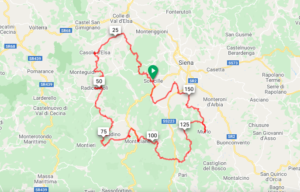 FIRST STAGE: CASOLE D’ELSA – SAN GALGANO
FIRST STAGE: CASOLE D’ELSA – SAN GALGANO
The route of Stage 1, from Casole d’Elsa to San Galgano, first runs along the Berignone Nature Reserve, the Val d’Elsa and the Val di Cecina, and then returns to the Val di Merse valley in Chiusdino.
With Andrea and Ingo Olie, bike guide and art expert, we leave Casole, a beautiful medieval village of Etruscan origin, pedaling through its flowery streets, narrow between stone buildings. We will visit it better at the end of the Gran Tour. Instead we head straight to Mensano, crossing a mosaic of cereal fields, groves, olive groves and vineyards. The landscape is open, with a beautiful panorama, on the West, on the Val di Cecina and, on the South, on the Montagnola Senese. At least a thousand years old, Radicondoli is curled up around the course. Its discreet charm derives from the possibility of getting lost in the quiet streets and admiring the mantra of hills and farms. From here on, Turkey oak, oak, downy and black hornbeam woods take over. Montalcinello, a hamlet of Chiusdino dating back to the 10th century and crouched on a hill covered with oaks, is an oasis of peace even in the high season. We pedal among the cobbled streets and then continue to Chiusdino. Perched in a spectacular position on the Val di Merse and on the Metalliferous Hills, the village is topped by a fortified medieval castle and was submitted first to the Bishops of Volterra and then, in the XIII century, to Siena.
It houses many interesting monuments, but is famous for the Cistercian abbey of San Galgano, which rises – roofless – a few kilometers further on. It is really exciting to reach this place by bike where the rarefied Gothic architecture of the 13th century church, left without the roof, seems to rise by magic from the sea of very blond wheat. We understand immediately that here the boundaries between history and imagination are diluted. There is a magical atmosphere: it is no coincidence that San Galgano has become a set of films and a stage for opera. The nearby Hermitage of Montesiepi (1185) preserves the sword stuck in the rock by San Galgano who, before discovering his vocation and retiring here as a hermit, was a knight often engaged in duels and battles.
SECOND STAGE: SAN GALGANO-PALAZZO A MERSE
The first part of the route takes us to the Monticiano area, and we immerse ourselves in the natural reserves of the Upper and Lower Merse River, characterized by broad-leaved coppice vegetation which is supplanted, in the higher areas, by chestnut and pine forests.
Immersed in this wild territory, Monticiano stands on a hill overlooking the river. In the village you can admire the church of Sant’Agostino with the chapter house of the former convent decorated with frescoes by Bartolo di Fredi, Guidoriccio Cozzarelli and Giovanni di Paolo. The Gothic building is one of the oldest hermitages of the Augustinian order.
After crossing Iesa, with its flowered balconies and ivy-covered walls, we enter the Basso Merse Nature Reserve, full of holm oak woods, which also houses the extremely rare otter.
The landscape is gentle, with modest hillocks and cultivated flat stretches.
Approaching Murlo, the typical wooded landscape of the Val di Merse is supplanted by the scenic Crete Senesi, especially further north, in the area of Ville di Corsano, where the clay soils offer shades that change according to the seasons: green in spring, yellow in summer, brown in autumn and winter. Here the iconic cypresses abound. The point where the tracks of Strade Bianche, L’Eroica and the Gran Tour meet is between Vescovado di Murlo and Murlo, where we cycle for about 2 km on a beautiful dirt track.
Murlo, on the border between the Val di Merse and the Crete of the Val d’Arbia valley, is a village-castle nestled on a hill overlooking the lush Crevole valley. The origins of the place are linked to the Etruscan civilization, as evidenced by the findings of Poggio Civitate and Poggio Aguzzo. The fortified castle dates back to the XII century, when it was the main center of the Feud of the bishops of Siena. Today it testifies to the transformations that occurred at the end of the sixteenth century after the fall of the Republic of Siena. The walls are dominated by small houses that surround the Bishop’s Palace (now home to the Archaeological Museum), the prisons and the cathedral. Leaving the city walls, we head north towards Ville di Corsano, a hamlet of Monteroni d’Arbia, a rural area of elegant estates, with historic manor houses and ancient castle villages. We ride blessed among sinuous rural landscapes that seem to have come out of an Impressionist’s brush: expanses of wheat, hay bales, farms, farmhouses, vineyards flooded by a meridian light.
THIRD STAGE: PALAZZO A MERSE-CASOLE
At the start of the third stage, the first thing we do is reach the memorial stone dedicated to the famous cycling race for pro riders, Strade Bianche (one of the Spring Classics in the UCI-Union Cycliste Internationale calendar), and the homonymous Granfondo for amateurs, which is located near the Palazzo a Merse B&B. Then we enter the postcard alleys of Torri, a hamlet of Sovicille, where the cloister of the Abbey of Santa Mustiola of the XII century is kept, surrounded by three overlapping series of arches: in two-tone stone, terracotta and wood. Today we will cross the Montagnola Senese, a mountainous area between 400 and 600 meters above sea level, included in the municipalities of Casole d’Elsa, Monteriggioni, Siena and Sovicille. It is covered with oak and maple coppices and, in the higher areas, chestnut trees. The undergrowth is instead rich in juniper, honeysuckle, rock rose, holly and strawberry tree.
Montagnola Senese is the place of origin of the autochthonous pig, the Cinta Senese (whose meat appears in many local dishes) and is known for the Broccatello yellow marble quarries. Sovicille is located on the ancient Via Maremmana that connected the Siena hinterland with the Tyrrhenian coast. The area was already inhabited in the Stone Age and was also relevant in the Etruscan and Roman times.
Once in Scorgiano, we cycle between the orderly geometries of the grapes and the cypresses on a winding road that is lost along an endless series of ups and downs. Then Mensanello appears, wrapped in the typical Tuscan rural landscape. Finally here is the medieval skyline of Casole d’Elsa, where we go to admire the Collegiate Church of Santa Maria Assunta. Here, in addition to the fourteenth-century funeral monuments, there is also an altarpiece by Giovanni della Robbia and three paintings by the Senese Caravaggesque Rutilio Manetti. Do not miss the attached museum, where precious Etruscan finds are exhibited, including the head of a female statue (6th century BC) in Apuan marble, the leading piece of the archaeological section. The Grand Tour of Val di Merse ends here, and we can finally treat ourselves to a coffee and a snack at the Bike Lounge along the main street.
PRACTICAL INFO
ITINERARY DESCRIPTION
The Grand Tour of the Val di Merse is a ring route, permanent and well-marked, which crosses the entire Val di Merse and borders on the southern part of the Val d’Elsa. It is usually run counterclockwise. In its updated official version (including Casole d’Elsa), it is 172.8 km long with 3158 m of altitude gain.
Since we have included in the mileage also the short journeys to reach the structures where we stayed (recommended in the hotel box), our Grand Tour turned out to be a little longer: 177.4 km, with an elevation gain of 3176 m. If you wish, you can start from any city on the itinerary, but for logistical convenience, the tour we follow has Casole d’Elsa as its starting and arrival point. The basin of the Merse River is located in the southwestern area of the Sienese, wedged between the offshoots northeast of the Metalliferous Hills, extending into the territories of Chiusdino, Monticiano, Murlo and Sovicille. To the north it borders on the Val d’Elsa, which instead originates from the western side of the Montagnola Senese, diluting to the east in Chianti, while towards the Tyrrhenian Sea it meets with the Volterra and Val di Cecina. The most significant villages touched by the cyclotour are (in anticlockwise order): Casole d’Elsa, Mensano, Radicondoli, Montalcinello, Chiusdino, Monticiano, Iesa, Vescovado, Murlo, Ville di Corsano, Sovicille, Scorgiano, Mensanello.
THE ITINERARY STAGE BY STAGE
1st stage CASOLE D’ELSA – SAN GALGANO
Distance: 53.8 km
Altitude gain: 972mt
Journey time (excluding stops): 4 hours 30min
It starts from Casole d’Elsa following the SP 28 towards Mensano: the first 2 km 200mt until the junction with SP 27 are downhill. We continue keeping to the right and for 6 km until the junction of Mensano the alternate road climbs with flat sections. From the Mensano crossroads a descent of 1km 500mt takes us to the crossroads with the SP3. We turn to the right and we walk this beautiful road for 5km 500mt until the crossroads of Radicondoli where we turn right and in 2km 500mt of ascent we will arrive at the beautiful medieval village of Radicondoli. From the village we will go down the same road to return to the intersection with the SP 3 where we turn right. The road climbs gently for 3 km to the Belforte crossroads where a 1km 500m descent takes us to La Fornace where we turn left onto the SP 107, we follow this road for 10 km to La Battellona, the first 5 km are very smooth, then from Montalcinello we will find a succession of short climbs and descents. At Battellona we turn right on the SP 31/A towards Chiusdino which we reach with a regular climb of 3km 500mt. From Chiusdino, continue downhill for 1km 500mt towards Ciciano, then a counter slope of 1km 200mt brings us to Ciciano. From Ciciano the SP 31/A goes down for 3km 500mt until the junction with the SP441 where you turn left towards San Galgano. You ride for 8km 500m on the SP 441 mostly flat until you reach the abbey of San Galgano.
GPS track: https://ridewithgps.com/routes/26582583
2nd STAGE: SAN GALGANO-PALAZZO A MERSE
Distance: 79.5 km
Altitude gain: 1371mt
Journey time: 6 hours
From San Galgano we take the SP 441 which we travel for 2km 700mt until the intersection with the SP 73/bis where we turn right; the first kilometer is flat then goes up for 3 km to Monticiano. After the tour of the village, take the SP 32/A which goes down for 3km 500mt until you cross the Gonna stream. From here the SP 32/A goes up for 4 km up to the junction with the SP 32/B that we take by turning right towards Iesa which is reached in 5km, the first part is flat then a 600mt climb then a nice descent to the village. After passing Iesa, continue for 3km on the plain then ride on a long descent of 2km 300mt until the intersection with the SP4, where we turn right and, going downhill for 1km, we arrive at the intersection with the municipal road of Montepescini: here we turn left towards Montepescini. Continue downhill for 2km until crossing the Merse river. Now the communal road climbs for about 9km to the town of Casciano di Murlo. After passing the village, take the SP 46 for 2km to the junction with the SP 33 where you turn right towards Murlo. The SP 33 climbs for about 600m up to the Rospatoio Pass then continues with a nice descent of 5km 500 to Vescovado di Murlo where you take on the right the SP 34/C which in 2 km takes us to the castle of Murlo. Let’s go back on the same road for 2 km until the junction with SP 33, then we turn left and ride 1km flat. Turn right towards Radi on SP 34/B, the beautiful dirt road that starts with 500mt of steep descent and takes us in 4 km of uphill and downhill to Radi, where we take the SP 32/B to the left. The road follows the beautiful hills and with steep climbs and equally steep descents in 4km and 500mt you reach the Ville di Corsano where we turn right onto the SP 46. Now we go down for 4km 500mt before turning left on the gravel road of Mugnano-Fogliano. The dirt road begins with a stretch of 400 meters of steep descent followed by a 1km climb, then another 5 km with alternating flat stretches, descent and ascent before getting to the intersection with the Grossetana road. Turn left and in 2km of easy riding we get to San Rocco a Pilli, where, after the village, we have to turn right into Via del Poggetto: the beautiful municipal road goes down for 3 km until you find the municipal road La Vidritta where there is the memorial stone dedicated to the famous professional race Strade Bianche. Here you leave the Grand Tour of the Val di Merse by turning left onto another flat white road which in 2 km crosses the SP99, here we turn right and in 300 meters we reach Palazzo a Merse.
GPS track: https://ridewithgps.com/routes/26582601
3rd STAGE PALACE IN MERSE-CASOLE D’ELSA
Distance: 44.1 km
Altitude gain: 833mt
Journey time: 3 hours 30 min
You exit the B&B Palazzo a Merse to take the SP99, turning right for 200m and then left, pedaling on a beautiful dirt road that we travel for 2km until you reach the junction with the municipal La Vidritta, famous for being the first gravel sector of Strade Bianche cycling race. We pedal on La Vidritta for 2km flat. Arrived at the crossroads with the SP99, we turn right and in 3 easy km we reach Rosia, where we cross the SP 73 / bis. Here we turn right, pass the town and with another 2km 500mt flat we reach the crossroads with the SP 37, turn it on the left and in 1km 700mt of climb we reach Sovicille, where we turn left on the SP 52, which we will travel for 7km. The road that crosses the Montagnola Senese rises from Sovicille to Passo Incrociati pass, where we turn right onto a dirt road, which in 3km of ups and downs brings us to cross the SP 101/a. We take it turning left, pedaling uphill for 2km 700mt then we begin a long descent that takes us to the crossroads with the SP 74/a where we turn left. We walk only 200m and we turn left on SP 541. We ride the SP 541 for 200m and we turn right on the SP 74/b, where we find a steep climb of 500m; the road continues in a valley for 7km until the junction with the SP 27 / a. We take the SP 27/a, turning left and with the last 2 km climb we arrive at Casole d’Elsa.
GPS track: https://ridewithgps.com/routes/26582623
WHAT TO KNOW
Best period: from March to late October
Bike to use: the route takes place almost exclusively on asphalt roads, except 12 km of gravel roads, for which hybrid or road bikes are recommended. We recommend e-bikes to the less trained cyclotourists, because the area is very undulating.
Bike Guides: Ingo Olie of Sherpa Italia (Mobile 3474924357) and Andrea Rossi (Mobile 3386762818).
Important events: At the beginning of March it is usually held the most important event in the area: the race for pro cyclists Strade Bianche, where all the World Tour teams (the “Serie A” of this sport, just to understand) take part. The following day it is held the Gran Fondo Strade Bianche, where amateurs can participate. L’Eroica, the famous “vintage” cross-country cycling race, takes place in October.
TO READ
Val di Merse by bicycle by Andrea Rossi, Jacopo Ruotolo, Enrico Caracciolo,
Ediciclo 2009, 113 pages.
WHERE TO STAY
Agriturismo Cielsereno
Stone farmhouse with panoramic swimming pool on the hills. You are staying in elegant apartments with gardens, decorated in a contemporary style with traditional touches. The company produces three Doc red wines and an organic extra virgin olive oil. Bikes can be stored in the apartments.
Casole d’Elsa (SI) Locality Cetinaglia, 0577 963013; agriturismocielsereno.it
San Galgano Farmhouse
Immersed in meadows and woods, it is a rustic estate close to the famous Cistercian abbey. It has rooms with wrought iron beds and parquet flooring in the farmhouse, or modern apartments with terracotta floors in the adjoining building. Indoor storage for bikes with insurance coverage and external laundry with 24-48 hour service.
Chiusdino (SI) Municipal Road of San Galgano 151 Location San Galgano, tel. 0577756292; sangalgano.it
Palazzo a Merse B&B
In the past, this farm with swimming pool was a “village” where the workers of the adjacent medieval mill worked. It is a very bike friendly B&B and is located near the route of Strade Bianche, as well as the Grand Tour. It offers a beautiful garden, charming rooms and apartments, storage and washing for bikes, tools, bicycle workshop, laundry, info on cycling routes. Possibility of preparing packed meals.
S.Rocco a Pilli (SI) Location Palazzo a Merse, Tel. 0577 342063; palazzomerse.it.
WHERE TO EAT
Osteria Caffè Casolani
Charming “hybrid” venue: it is a café, tavern and wine bar. Beyond the ancient counter for serving, you can sit in the back for lunch with cold cuts, first courses, local cheeses. At dinner you choose from the set menu, savoring excellent Tuscan dishes: Chickpea soup, Spelled and Tarragon sauce; Pici alle Briciole; Chianti tuna with beans in flask; Lamb ribs with thyme with artichokes.
Casole d’Elsa (SI) Via Alessandro Casolani 41 tel. Tel. 0577 948733; caffecasolani.com. Average price: € 25-30.
Bottega di Stigliano
More than a restaurant or a shop of local delicacies: this farmhouse with outdoor terrace is devoted to the culinary tradition of the area, and is the crossroads of a network of selected producers. It defines itself as a “laboratory of citizenship around food” to taste the colored pasta, the Cinta Senese ham, the stewed wild boar, the sliced chianina.
Stigliano (SI) Piazzetta di Stigliano 62, tel. 0577 345624; labottegadistigliano.it. Average bill: € 25.
Bosco della Spina Country House
Traditional dishes cooked according to ancient family recipes to accompany a wide selection of wines. The outdoor tables are placed on a beautiful terrace in the greenery. Murlo (SI) Via della Tinaia 13, tel. 0577 814605; boscodellaspina.com. Average bill: € 30.
La Botteghina di Scorgiano
Monteriggioni (SI) Località Scorgiano 4, Tel. 0577 301242; scorgiano.it. Perfect, while pedaling, for an outdoor snack based on cold cuts, genuine cheeses, craft beers and local wines (products can also be purchased to take away).
Podere Paugnano
Radicondoli (SI) Location Podere Paugnano 33 tel. 0577 793027; poderepaugnano.it
Organic farm where you can buy excellent cheeses, dairy products and sheep’s yogurt. They also cook a few tasty dishes, like tortelli with ricotta cheese or baked lamb.
Barroccio Bike Lounge
Casole d’Elsa (SI) Piazza Della Libertà, tel. 0577 948603.
A very cyclist-friendly cafeteria, ideal for eating a sandwich or drinking a coffee: it offers free Wi-Fi and you can even take your bike inside in the special “sitting room” with sofas and bookcase. In the summer, you can sit outside.
Tenuta delle Macchie Winery
Truly superb the wines produced by the famous winemaker Paolo Caciorgna (consultant to Sting and many other celebrity winemakers) in his Tenuta delle Macchie (Località Molino d’Elsa 39, Casole tel. 348 7903804; tenutadellemacchie.com, visits and tastings by appointment).
Macchie Passito 2011, aged in barriques, has the sweetness of sun-dried grapes and aromas of blueberries, blackberries and black currants. Alberaia is a delicate Sangiovese with cherry notes; the Macchie is a rounder Sangiovese, with aromas of black fruits and spices.
MONUMENTS AND MUSEUMS
Abbey of San Galgano
Chiusdino (SI) San Galgano, tel. 0577 756738; comune.chiusdino.siena.it.
Hours: daily from November to March 9-17.30; April, May and October 9-18; June and September 9-19 and July-August 9-20.
Hermitage of Montesiepi
Chiusdino (SI) San Galgano, tel. 0577 756700; comune.chiusdino.siena.it. Hours: every day from 9 until sunset. Free entry. In winter the opening hours are not always respected (better to call first).
Civic and Diocesan Museum of Sacred Art of San Galgano
Chiusdino (SI) via Umberto I n.19 tel. 0577 756738; comune.chiusdino.siena.it Hours: November-March every day from 10 am to 6 pm; April-October 10-19. Admission: € 3.50.
Antiquarium of Poggio Civitate Archaeological Museum – Murlo
Murlo (SI) Piazza della Cattedrale, 4 Tel. 0577 814099; museisenesi.org. Hours: From October to March, from Friday to Sunday: 10.30 13.30 and 14.30-17.30. Admission: € 5.
Cloister of the Abbey of Santa Mustiola
Torri (SI) Piazza del Vescovado 6, comune.sovicille.siena.it. Hours: Mon and Fri (except holidays) 9-12. Free admission.
Civic, Archaeological and Collegiate Museum of Casole d’Elsa
Casole d’Elsa (SI) Piazza della Libertà 1, tel. 0577 948705; museisenesi.org.
Hours: From January 7th to Palm Sunday open on Sat, Sun and holidays
10-13.30 and 15-17.30. From Palm Sunday to 1st November open every day
10-13.30 and 15.30-18. Closed on Wednesdays (if not holidays). From November 2nd to December 26th open Sat, Sun and holidays 10-13.30 and 15-17.30. Christmas period: open every day from December 26th to 31st (closed on December 25th).
Admission: € 3.


